Botswana is made up of a staggering 58 173 000 hectares of pristine wilderness, mostly comprising of desert plains, but contrasted beautifully with white salt pans, woodland forests and a network of channels and lagoons.A safari vacation in Botswana may appear to be more expensive than other safari destinations in Africa, but the experience is of a high standard, most often in very remote and untouched parts of the country. The most beautiful destinations in Botswana can only be reached by light aircraft. The pace is also gentler, allowing one to truly immerse in nature and admire the smaller wondrous creatures of the African bush. Wildlife sightings are unquestionably more exclusive, most often only shared with those on your safari vehicle.With its diverse wildlife, unique safari experiences all year round, and exceptional standards of accommodation; it is no wonder that Chobe National Park and the Okavango Delta are Botswana’s most popular tourist destinations. If you’re visiting this part of Africa, the only problem you’ll have is knowing which of the two to choose for your next vacation! This is exactly why we’ve put these two parks head to head in a grand ‘safari showdown’.
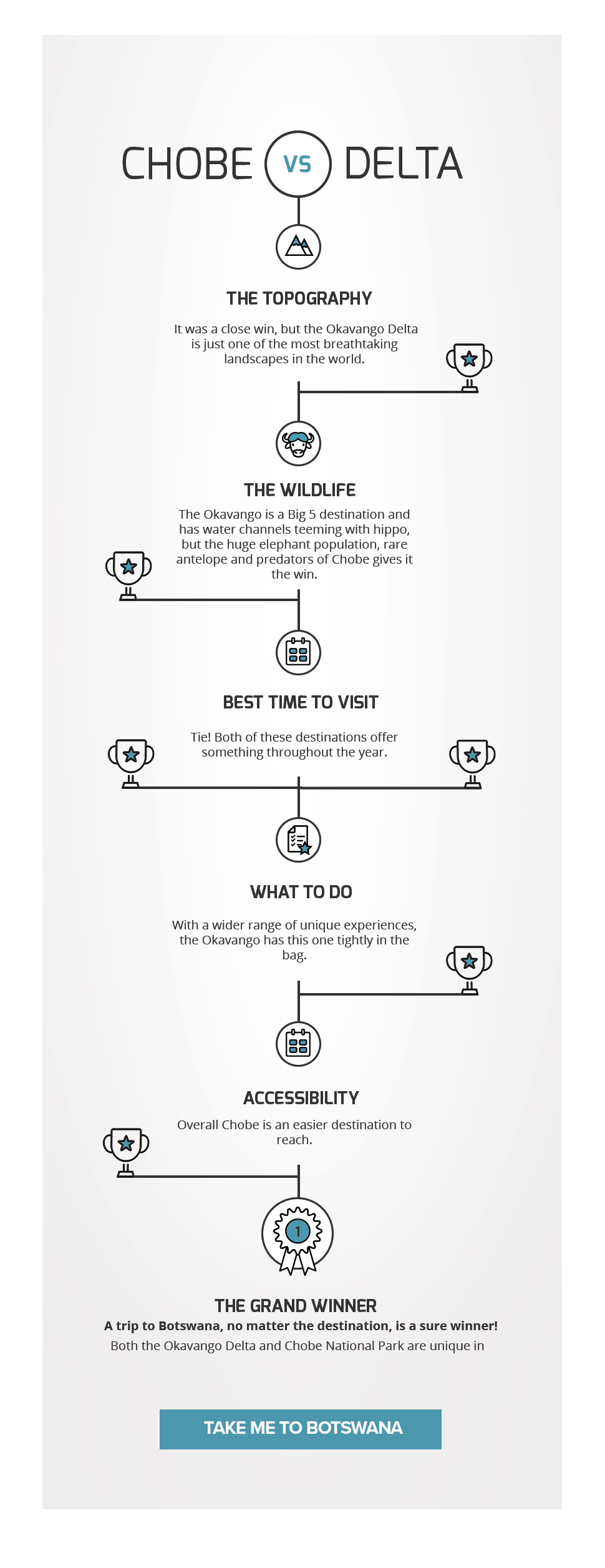
Chobe National Park vs Okavango Delta: The Topography
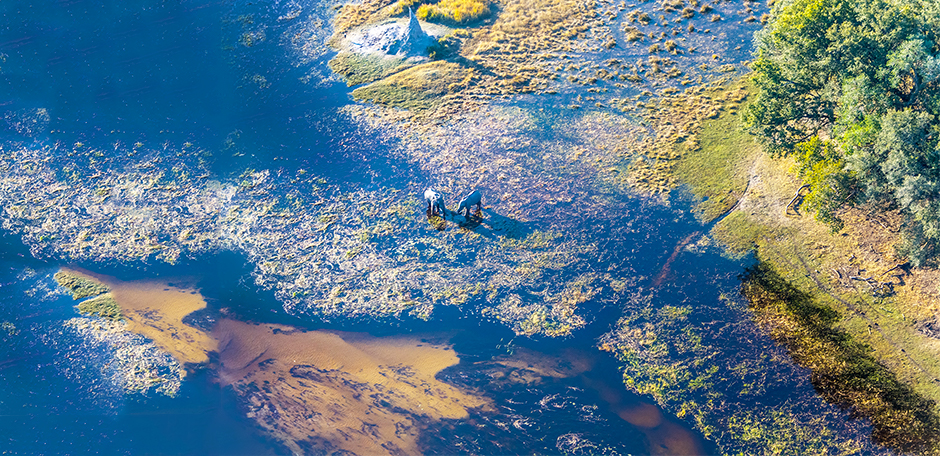
Chobe National Park
Declared in 1931 as Botswana’s first national park; Chobe National Park, which is located in the north of the country, is the third largest park after Central Kalahari Game Reserve and Gemsbok National Park. The park is divided into 4 areas, each promising an action-packed safari:
- Chobe Riverfront - situated in the extreme Northeast of the park, this area features lush floodplains and dense woodland. The Chobe River is a major watering spot, especially in the dry season (May through October). The floodplains are the only place in Botswana where the puku antelope can be seen.
- Savuti Marsh - An area of 10,878 square kilometers, the Savuti constitutes the western stretch of the park. Covered with extensive savannahs and rolling grasslands, this area is an attractive wildlife area and popular for its annual migration of zebras and predators.
- Linyanti Marsh - located at the northwest corner of Chobe and north of Savuti. This region comprises of woodland savannas, riverine woodlands, and lagoons. A large concentration of animals can be found in this region, particularly large herds of elephant and buffalo.
- Situated between the Linyanti and Savuti Marshes is the hot and dry hinterland which consists of grass woodland. This section is lesser known and is an ideal place for spotting eland.
Okavango Delta
The Okavango Delta is an inland delta that forms when the Okavango River reaches the central part of the basin of the Kalahari. It is a unique phenomenon because the water flowing into the Delta never reaches the ocean. As a result, the Okavango Delta became the 1000th site to be officially inscribed on the UNESCO World Heritage List.
- Floods - The flood season in Botswana is generally during the winter months of June to August. It is a great phenomenon to witness as the delta swells approximately three times in size and attracts an abundance of wildlife.
- Salt Pans - The collection of salt around plant roots results in barren white patches in the center of a number of the delta islands. These salts are rich in minerals and nutrients which attract numerous animals.
- Chief’s Island - Chief’s Island is undoubtedly the largest island in the delta. Historically, it was intended to be a private hunting area for the chief of the island. Today this island is home to some of Africa's most incredible wildlife, especially during the flood season.
Best Topography Winner: Okavango Delta. It was a close win but the Okavango is an untouched wilderness that is undeniably breathtaking.
Chobe National Park vs Okavango Delta: The Wildlife
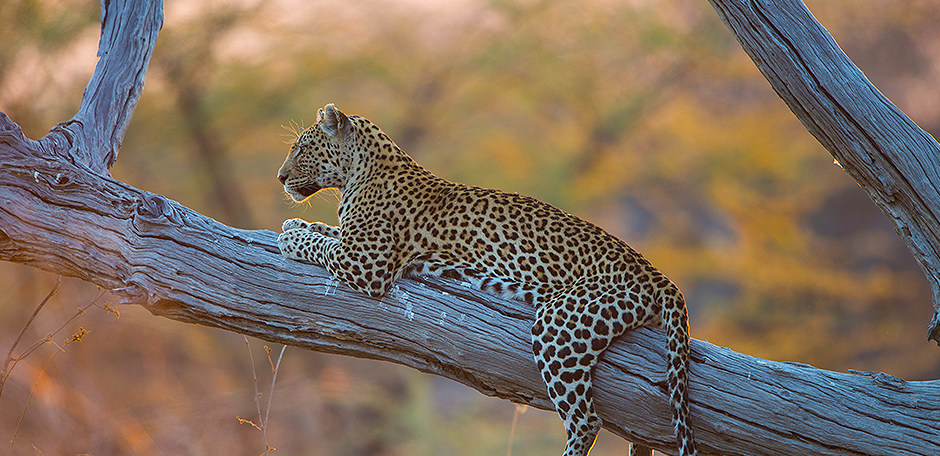
Chobe National Park
Chobe National Park is an incredibly diverse wildlife destination with an abundance of animals inhabiting the region. It is home to four of the Big Five - lion, leopard, buffalo and elephant, as well as other animals like zebras, kudu, hyenas, red lechwe and some of the less common animals like eland, sable and roan antelopes. You can also easily see cheetah, endangered wild dog and over 450 species of bird. The real highlight however is Chobes’ huge elephant population, the largest in the world (over 120,000), making it an ideal destination on the planet to see these majestic creatures in their natural habitat. You can often see elephant herds of 5000 or so at the Chobe River.
Okavango Delta
The Okavango Delta is home to an incredible variety of wildlife. There are an estimated 200,000 large mammals inhabiting the delta during the drier seasons. They tend to leave the delta when the summer rains arrive, searching for greener grasslands elsewhere before making their way back to the delta as winter approaches. Large mammals inhabiting the delta include elephants, buffalo, black and white rhino, leopard, lion, hyena, cheetah, buffalo, and wildebeest; whilst hippos and Nile crocodiles line the channels.One of the attractions to the Okavango Delta is the bird watching opportunities. With over 400 species recorded, the Delta is a bird lovers paradise in the rainy months.Best wildlife winner: Chobe National Park. The Okavango is a Big 5 destination and has water channels teeming with hippo, but the Chobe has hundreds of elephants, rare antelope and even leopards in trees.
Chobe National Park vs Okavango Delta: Best Time to Visit
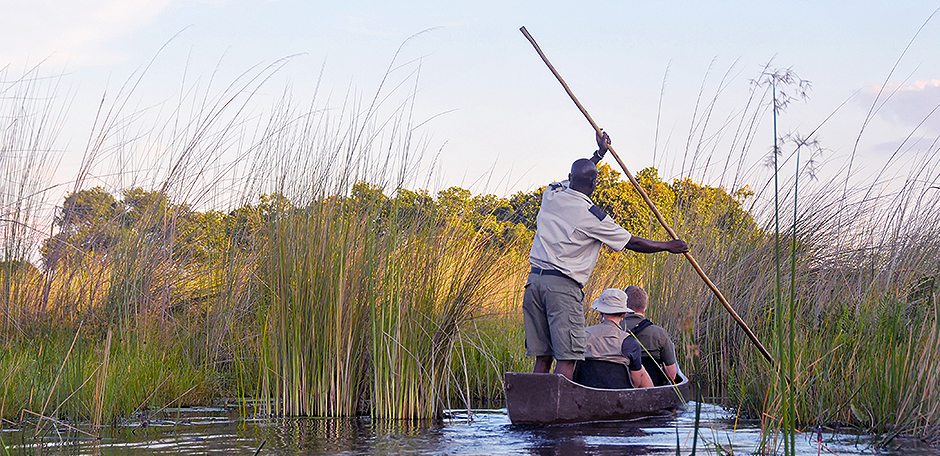
Chobe National Park
Many travelers prefer to embark on a safari in Chobe National Park during the dry season due to the Chobe River being the main source of water for animals, encouraging them to stay around the river. The hotter months of August through October present the opportunity for some sensational game viewing - provided you can stand the heat.Many of the bird species in Chobe are migratory – making the warm and wet summer months of December to March the perfect time of the year for a bird watching adventure.
Okavango Delta
The cooler, drier winter months from May to October are excellent for game-viewing as herds of animals flock to decreasing water sources and the vegetation thins out. Days are warm; nights can be cold, especially in the desert. This is also the period when floodwaters reach the Delta making for excellent water-based activities such as boating and mokoro rides.The hot, wet summer months from December to March are great for bird watching when migrants are plentiful. This is also the animals’ calving season, so it’s perfect for seeing playful babies.Best time to visit winner:It’s a tie. Both of these destinations offer something throughout the year.
Chobe National Park vs Okavango Delta: What to do
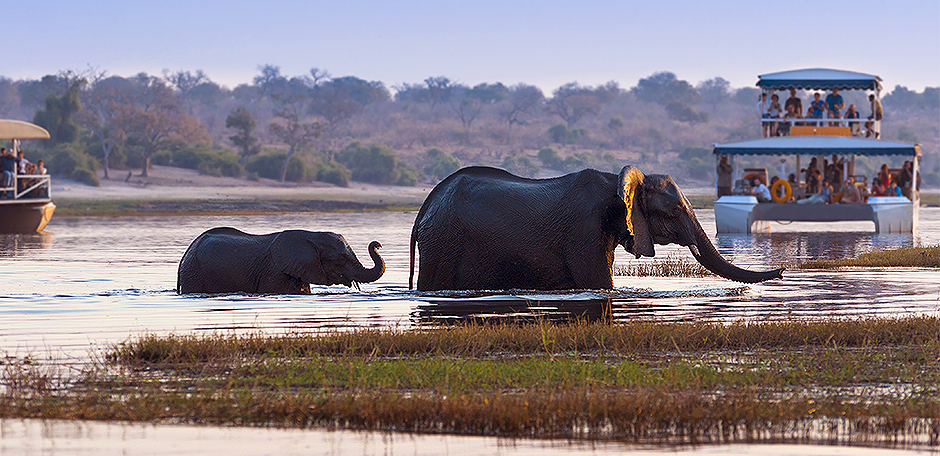
Chobe National Park
A safari in Chobe is special because of the different ways one can experience this pristine part of Africa. Whether in a vehicle, on foot or on the water, Chobe offers an unforgettable safari experience in the African bush. If you not staying at a lodge that includes safari activities, it is always recommended that you book prior to arrival as the park can get extremely busy.
- Game drives - the best way to see predators, the various ecosystems, and attractive landscapes.
- Boat cruises - a favorite for bird lovers and photographers with majestic sunsets, large herds of elephants crossing the river and up-close views of gigantic hippo and Nile crocodiles lurking in the river.
- Fishing - home to the legendary Tigerfish and several species of bream, Chobe is a popular fishing destination.
- Guided bush walks - There is no better way to explore the African bush than on a bush walk. It will most certainly heighten your senses and is the perfect way to learn more about the ecosystems and spot birds.
- Elephant interactions - Elephant back safaris have been phased out in Botswana due to concerns over animal welfare. Lodges now offer elephant interaction and educational talks, including a captivating experience of walking with elephants.
- Village tours - the perfect way to gain insight into the local culture is to spend time with a select few tribal villages that can be found on the Namibian side of the Chobe River. This is a truly rewarding experience.
Okavango Delta
A safari in the Okavango is one of the most unique experiences you will ever encounter in this lifetime. Discover the famous Big 5 on game drives led by professional guides, to serene mokoro trips in the lagoons and helicopter flight over the dramatic landscapes. There is no shortfall of adventure in the Delta.
- Game drives - dependent on the camp’s location and the season, game drives are generally offered in both the morning and late afternoon. As most lodges are located in private concessions, night drives are possible and provide the opportunity to see the many animals that are more active at night.
- Mokoro trips - The Delta is famous for its traditional Mokoro (dugout canoe) experiences, the perfect way to glide through the shallow channels and see wildlife grazing on the land.
- Boating safaris - Water based camps generally offer game viewing by motorboat, which is sure to offer a different perspective to your safari experience.
- Fishing - Sometimes only offered seasonally, most water-based camps will allow catch and release fishing. The Delta is a great place to try your hand at catching a Tigerfish or Tilapia.
- Guided bush walks - There is no better way to get up close and personal with the African bush than on a bush walk. The guides will help you track animals and is a great way to spot the smaller wondrous creatures of Africa, as well as the many birds found in this region.
- Horseback Safaris - these usually take place on the seasonal floodplains in the southwestern areas of the Delta and are conducted by experienced guides who will lead you down paths that showcase the delta's beauty.
- Elephant interactions - Elephant back safaris have been phased out in Botswana due to concerns over animal welfare. Lodges now offer elephant interaction and educational talks, including a captivating experience of walking with elephants.
- Helicopter flights - The spectacle of the Okavango Delta is probably best viewed from the air. Scenic helicopter flights are a wonderful way to see the vast plains and endless waterways that are the framework of the Okavango Delta.
Most things to do winner: Okavango Delta. With a wider range of unique experiences, the Okavango has this one tightly in the bag.
Chobe National Park vs Okavango Delta: Accessibility
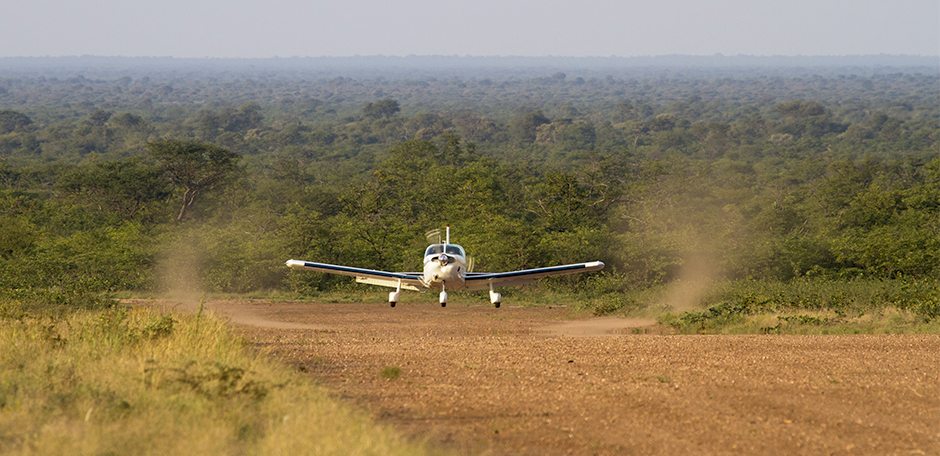
Chobe National Park
Chobe National Park is accessible in a variety of ways, with most travelers choosing to take a scheduled flight to Kasane Airport and then road transferring to their lodge. Positioned at the border of Zambia, Zimbabwe, Namibia, and Botswana; Chobe is also accessible by road making self-drives possible but it is important to know that a suitable vehicle is required to get through the somewhat sandy terrain.
Okavango Delta
The easiest way to visit the Okavango Delta is by scheduled charter flights from Maun Airport. On arrival at the lodge’s nearest airstrip, you are met and transferred by a road and/or boat to your lodge. The eastern part of the delta can also be accessed directly from Maun by 4x4, without the need for a chartered flight. Some safaris run 4x4 mobile camping trips from Maun.Accessibility winner:Chobe National Park. Overall Chobe is an easier destination to reach.
The Grand Winner
A trip to Botswana, no matter the destination, is a sure winner!Although Chobe National Park may have narrowly sneaked in for the win, it is difficult to truly measure two exceptional parks as these. Each is unique in their own way and offer extraordinary experiences. It is safe to say that the overall conclusion is this:
- Chobe is the perfect choice for travelers seeking an adventure safari, with phenomenal big game viewing and fantastic elephant sightings.
- The Okavango Delta is for the traveler wanting a private and remote safari experience, and the opportunity to discover what makes a “mokoro ” so special.
Of course, if you have the resources to experience both parks then the battle is won!

